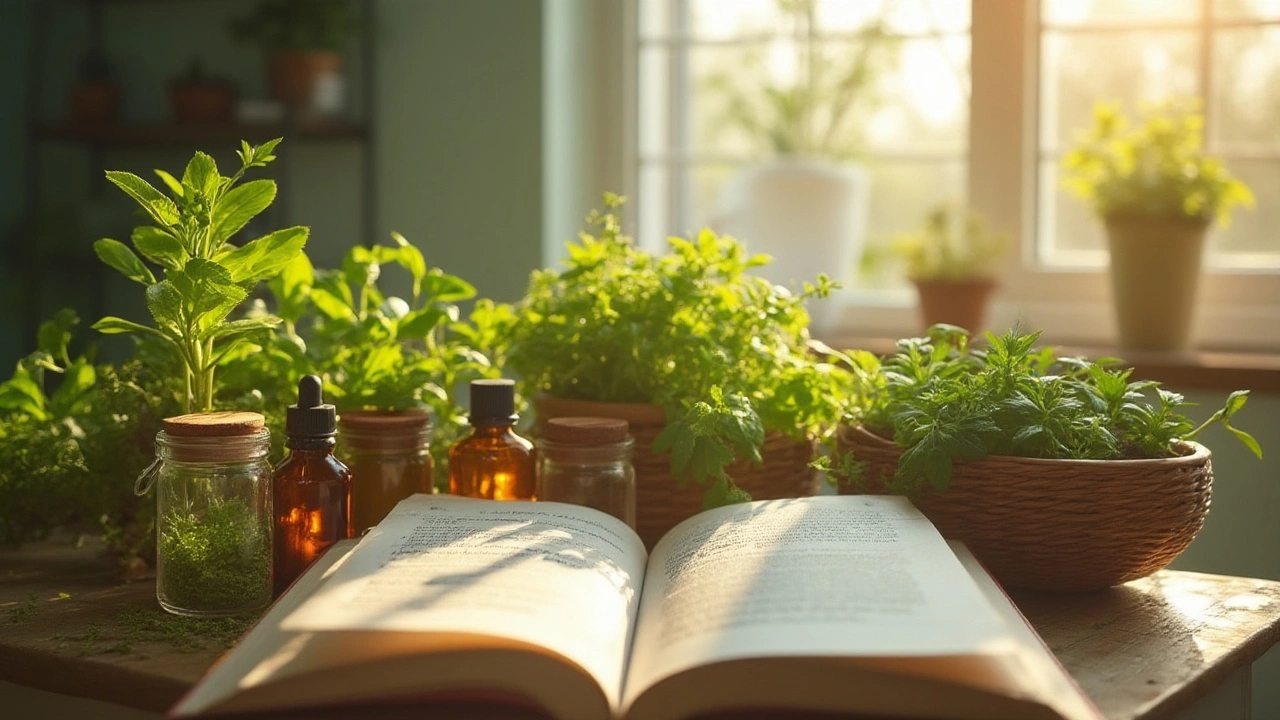Imagine popping open a bottle of pills and finding—rather than chemicals with unpronounceable names—a blend of herbs your grandma might recognize. That’s what gets some people buzzing about Septilin. Forget the hype about magic cures and quick fixes; let’s unravel why this herbal supplement attracts so much attention, whether you’re scrolling TikTok or asking about it at a pharmacy.
What Exactly Is Septilin?
Septilin isn’t something you’re likely to come across at every corner store. This supplement comes from Himalaya Herbal Healthcare, blending a bunch of plant-based extracts straight out of Ayurveda—the thousands-year-old Indian system of medicine. And no, it’s not a new trend; Septilin has been around for decades. There’s a reason it’s always in demand—people swear by it for keeping sniffles and sore throats at bay. The formula brings together herbs like Tinospora cordifolia (giloy), licorice, Indian Bdellium (guggul), and a few more, all brewed into syrup or pressed into tablets.
What makes this stuff different from other supplements? It skips the whole synthetic chemical route and steers right into ancient wisdom—except, these days, you’re getting consistent manufacturing and packaging, not some risky backyard brew. That means purity and safety are a bigger priority. Here’s what’s inside each dose (according to Himalaya’s official product info as of 2024):
| Ingredient | Key Purpose |
|---|---|
| Tinospora cordifolia (Guduchi) | Supports immune response |
| Licorice (Glycyrrhiza glabra) | Soothes the throat |
| Guggul (Commiphora mukul) | Traditional detox effects |
| Indian Grape (Vitis vinifera) | Antioxidant |
| Maharasnadi Quath | Joint support |
It isn’t just a random mix. The company designed the blend for supporting regular immune function—think: fewer sick days, less time blowing your nose, and less drama from seasonal bugs. Thousands of people use it for exactly that, often as a daily tonic, or when they feel a cold coming on.
Health Benefits of Septilin
When people talk about Septilin, their first thought is usually immune support. No surprise—studies published in journals like the “Indian Journal of Pediatrics” (2019) suggest it can make a difference for those prone to recurring upper respiratory infections. Unlike some supplements that have next to no research, Septilin actually shows up in clinical trials. For example, a group of pediatricians reported in a 2015 study the supplement helped cut infection frequency among school-age kids by half after just three months of daily use. That’s a real number—it means fewer antibiotic prescriptions, fewer fevers, and way more classroom time.
It doesn’t stop at colds. Dermatologists sometimes recommend Septilin for skin health, especially when breakouts or rashes are triggered by immune imbalance or inflammation. Sore throat? Septilin pops up in plenty of online reviews as a go-to remedy—partly because licorice and guduchi shine at calming stingy, raw throats.
Some extra fringe benefits sneak in too. Guggul has a rep for helping manage minor swelling and joint discomfort. Plus, there’s talk that the antioxidant power from Vitis vinifera (that’s common grape) fights free radicals—those pesky molecules linked to aging and chronic conditions. All this doesn’t mean Septilin is a magical shield, but users notice they bounce back quicker from bugs, feel less run down, and put antibiotics on the back-burner for minor infections.
So does everyone react the same way? Of course not. Women juggling busy careers and young kids write about using it as an immune "insurance policy.” Students say they lean on it during exam season because nothing ruins finals like getting sick. Even some athletes throw it in their recovery routine because intense exercise sometimes knocks the immune system off balance.
Several doctors have gone on record—not as miracle claims, but with cautious optimism. As Dr. Rajeshwari T, an immunologist at Kasturba Medical College, put it,
"Herbal blends like Septilin should never replace medical treatment, but they're a smart addition for people who get sick often and want to support their body's natural defenses."If you always catch the flu at the worst possible moment, this supplement’s reputation for immune support might be worth a closer look.

Who Should (and Shouldn’t) Use Septilin?
Not every bottle is one-size-fits-all. Septilin, like any supplement, makes sense for some and not others. If you find yourself always dragging around because of a never-ending cold or minor infections—and there’s no serious underlying health problem—adding it to your wellness toolkit could make sense. It’s reportedly safe for most adults and even for kids (under guidance). It’s gluten-free, and generally, the list of side effects is short, especially when compared to many pharmaceuticals.
But don’t just toss it into your routine without thinking. If you have autoimmune illnesses—like lupus or rheumatoid arthritis—tread carefully. Septilin is made to nudge the immune system into high gear, and that’s the last thing you want with illnesses that already have an overactive immune response. Same goes for anyone on immunosuppressive drugs or after transplants—definitely get the green light from your doc first.
Pregnant or breastfeeding? The evidence just isn’t there—better safe than sorry. Young children should only take it if a pediatrician is on board. Also, folks sensitive to any of the plant ingredients, especially licorice (which can tinker with blood pressure if used in giant doses), should be cautious. It’s an herbal blend, but it has real effects.
On the flip side, vegetarians and those looking for non-animal wellness aids can use it with peace of mind. It doesn’t contain common allergens like dairy or soy in its standard form. People recovering from surgery, students under exam stress, and those with minor seasonal illnesses have all included it in their wellness routines, but again, moderation matters.
If you’re popping multiple supplements or have health conditions, the best move: talk with your healthcare provider before mixing anything into your daily meds. Even something from nature can interact with modern meds, so don’t skip that check-in.
Septilin Dosage, Best Practices, and Tips
There isn’t a single "magic number" for Septilin dosage. Adults usually take two tablets twice daily, and for kids, the typical dose is one tablet twice daily, or a teaspoon (5ml) of syrup twice a day. You can grab it with or without meals, but some find they digest it more comfortably with food. If you’re trying it for the first time, starting with a low dose and bumping it up over a week helps spot any surprise reactions.
- For routine immune support: Stick with the standard dose for 2-3 months, reevaluate with your doctor, and adjust if needed.
- If fighting an infection (under doctor’s advice): Dosage can be temporarily increased—always follow healthcare provider instructions.
- Missed a dose? Don’t double up. Just take your next dose as scheduled.
- Store the tablets or syrup away from heat and sunlight to keep the herbs potent.
- Be alert for any allergic rash, new digestive symptoms, or headaches—these are rare, but worth watching for, especially if you’re sensitive to plant extracts.
- If you’re using the syrup, shake well before use; sometimes the herbal residues settle at the bottom.
Septilin is usually safe for daily use over months, but like any supplement, it isn’t meant for indefinite, mindless use. If you start seeing tangible improvements—like fewer infections or less reliance on antibiotics—great. If you notice no change after three months, check with your doctor to see if something deeper is going on, like allergies, a vitamin deficiency, or chronic inflammation.
One tip you’ll hear from seasoned users: Septilin works best as part of a routine that includes normal hygiene, handwashing, healthy eating, and enough sleep. It’s not a magic force field—just another layer of support when you want to keep going, not slow down for yet another cold.

Stories and Real-Life Results
People’s real stories bring all the facts to life. Take Priya, a 38-year-old teacher in Mumbai, who writes about catching colds on a near-monthly basis until she started taking Septilin last year. She pairs it with vitamin C and swears she now misses fewer school days—plus, she feels less wiped out during allergy season. Parents of kids with repeat sinus infections have reported fewer school absences and less stress during winter months after about 8-12 weeks on the supplement.
It’s not just kids and moms, either. College students crammed into dorms (where bugs spread like wildfire) use Septilin as an extra layer of protection. A few Indian cricket team members have given it shout-outs in interviews, mentioning that it helps them avoid downtime during key seasons when fitness is critical.
One fun fact: Septilin has been included in the wellness routines at some call centers and corporate offices in India as part of company wellness drives—less sick leave benefits everyone, after all. A small 2021 survey in Bangalore-based tech firms found workers using Septilin as part of workplace wellness kits reported slightly fewer sick days on average compared to those who didn’t. But don’t expect instant miracles—most case descriptions say results show up after regular use, not just one or two doses.
One thing users consistently mention: when paired with lifestyle changes, normal vaccines, and a balanced diet, Septilin acts like a supporting actor. It’s not there to replace common sense things like getting your flu shot or going to the doctor when you’re sick. It partners best with, not instead of, good habits and solid healthcare.
You’ll see some folks who try it and decide it’s not for them, often because they seek instant results or dislike the herbal aftertaste. That’s fine; no two immune systems act the same. But scroll through enough reviews, talk to enough users, and you’ll find people who quietly keep restocking that green bottle for themselves and their families year after year.

Chelsey Gonzales
July 15, 2025 AT 12:15MaKayla Ryan
July 17, 2025 AT 05:56Kelly Yanke Deltener
July 17, 2025 AT 21:40Sarah Khan
July 18, 2025 AT 22:35Kelly Library Nook
July 19, 2025 AT 05:03Crystal Markowski
July 19, 2025 AT 15:05Charity Peters
July 19, 2025 AT 15:42Faye Woesthuis
July 19, 2025 AT 16:19raja gopal
July 21, 2025 AT 11:54Samantha Stonebraker
July 23, 2025 AT 06:36Kevin Mustelier
July 24, 2025 AT 00:50Keith Avery
July 24, 2025 AT 23:44Luke Webster
July 25, 2025 AT 14:02Natalie Sofer
July 26, 2025 AT 09:13Tiffany Fox
July 26, 2025 AT 18:14Rohini Paul
July 27, 2025 AT 11:29Courtney Mintenko
July 29, 2025 AT 04:37Sean Goss
July 30, 2025 AT 06:55Khamaile Shakeer
July 30, 2025 AT 14:00Suryakant Godale
July 31, 2025 AT 13:23